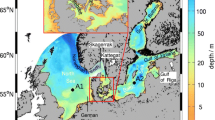Abstract
The “weak-interaction” approximation is used to investigate the role of wind waves in tidal dynamics. The resulting expression for the drag coefficient in the wave-affected tidal flow is incorporated into the QUODDY-4 three-dimensional finite-element hydrothermodynamic model, and the thus modified model is used to calculate the K 1 diurnal tide in the Pechora Basin-White Sea subsystem. It is shown that, depending on a combination of local and nonlocal factors, wind waves can cause opposite variations in the amplitudes and phases of tidal oscillations of the level. Local factors control variations in the tidal regime nearly in the entire water area of the subsystem under consideration, apart from the eastern part of the Pechora Basin, the outlet from the White Sea Throat, and Dvina Bay. In the aforementioned areas, the tidal regime changes are due either to the displacement of the nearest amphidromy or to other nonlocal factors resulting from the reorganization of the fields of tidal characteristics. It is also shown that the variations in tidal characteristics induced by wind waves vary within a fairly wide range and that allowance for the interaction of wind waves and tides improves the agreement between calculated and observed values of the amplitudes and phases of tidal oscillations of the level.
Similar content being viewed by others
References
E. V. Semenov and M. V. Luneva, “A Numerical Model for the Tidal and Thermohaline Circulation of Water Masses in the White Sea,” Izv. Akad. Nauk, Fiz. Atmos. Okeana 32, 704–713 (1996) [Izv., Atmos. Ocean. Phys. 32, 650–659 (1996)].
E. V. Semenov and M. V. Luneva, “Combined Effect of Tide, Stratification, and Vertical Turbulent Mixing on the Formation of Hydrophysical Fields in the White Sea,” Izv. Akad. Nauk, Fiz. Atmos. Okeana 35, 660–678 (1999) [Izv., Atmos. Ocean. Phys. 35, 599–615 (1999)].
W. D. Grant and O. S. Madsen, “Combined Wave and Current Interaction with a Rough Bottom,” J. Geophys. Res. C 84, 1797–1808 (1979).
B. A. Kagan and K. B. Utkin, “Weak Interactions between Wind Waves and Tides and the Drag Coefficient in a Tidal Flow,” Izv. Akad. Nauk, Fiz. Atmos. Okeana 36, 566–574 (2000) [Izv., Atmos. Ocean. Phys. 36, 522–529 (2000)].
L. V. Aleksandrova, S. A. Tyuryakov, and B. A. Kagan, “On the Adequacy of the Weak Wind Wave-Low-Frequency Current Interaction Formulation,” Izv. Akad. Nauk, Fiz. Atmos. Okeana 41, 691–694 (2005) [Izv., Atmos. Ocean. Phys. 41, 628–631 (2005)].
A. G. Davies, R. L. Soulsby, and H. L. King, “A Numerical Model of the Combined Wave and Current Bottom Boundary Layer,” J. Geophys. Res. 93, 491–508 (1988).
B. A. Kagan, O. Alvarez, and A. Izquierdo, “Weak Wind-Wave/Tide Interaction over Fixed and Moveable Bottoms: A Formulation and Some Preliminary Results,” Cont. Shelf Res. 25, 753–773 (2005).
B. A. Kagan, “On the Resistance Law for an Oscillatory, Rotating, Rough, Turbulent Flow,” Izv. Akad. Nauk, Fiz. Atmos. Okeana 39, 834–838 (2003) [Izv., Atmos. Ocean. Phys. 39, 754–757 (2003)].
J. T. C. Ip and D. R. Lynch, QUODDY3 User’s Manual: Comprehensive Coastal Circulation Simulation Using Finite Elements: Nonlinear Prognostic Time-Stepping Model (Thayer School of Engineering Dartmouth College, Hanover, 1995), No. NML 95-1 (http://wwwnml.dartmouth.edu/Software).
D. R. Lynch and F. E. Werner, “Three-Dimensional Hydrodynamics on Finite Elements. Part II: Non-Linear Time-Stepping Model,” J. Numer. Meth. Fluids 12, 507–533 (1991).
B. A. Kagan and A. A. Timofeev, “Dynamics and Energetics of Surface and Internal Semidiurnal Tides in the White Sea,” Izv. Akad. Nauk, Fiz. Atmos. Okeana 41, 550–566 (2005) [Izv., Atmos. Ocean. Phys. 41, 498–512 (2005)].
G. D. Egbert and S. Y. Erofeeva, “Efficient Inverse Modeling of Barotropic Ocean Tides,” J. Atmos. Ocean. Tech. 19, 183–204 (2002).
L. Padman and S. Erofeeva, “A Barotropic Inverse Tidal Model for the Arctic Ocean,” Geophys. Res. Lett. 31, 1029 (2004).
M. Jakobsson, N. Cherkis, J. Woodward, et al., “A New Grid of Arctic Bathymetry: A Significant Resource for Scientists and Mapmakers,” EOS Trans. Am. Geophys. Un. 81(9), 89, 93, 96 (2000) (http://www.ngdc.noaa.gov./mgg/mathymetry/arctic/arctic.html).
R. G. Dean, “Intercomparison of Near-Bottom Kinematics by Several Wave Theories and Field and Laboratory Data,” Coast. Eng. 9, 399–437 (1986).
Q.-P. Zou, A. E. Hay, and A. J. Bowen, “Vertical Structure of Surface Gravity Waves Propagating over a Sloping Seabed: Theory and Field Measurements,” J. Geophys. Res. C 108, 3265 (2003).
Handbook on the Regime of Wind and Wind Waves on the Seas Flowing around the USSR Coasts (Morskoi Transport, Leningrad, 1962) [in Russian].
J. D. Smith and S. R. McLean, “Spatially Averaged Flow Over a Wave Surface,” J. Geophys. Res. C 82, 1735–1746 (1977).
N. N. Zubov, Arctic Ices (Izd. Glavsevmorputi, Moscow, 1945) [in Russian].
K. C. Wong and J. H. Trowbridge, “Some Observational Evidence on the Effect of Atmospheric Forcing on Tidal Variability in the Upper Delaware Bay,” J. Geophys. Res. 95, 16229–16240 (1990).
A. Guttierez, F. Mosetti, and N. Purga, “On the Indetermination of the Tidal Harmonic Constants,” Nuovo Cimento C 4, 563–575 (1981).
O. Alvarez, B. Tejedor, L. Tejedor, and B. A. Kagan, “A Note on Sea-Breeze-Induced Seasonal Variability in the K1 Tidal Constants in Cadiz Bay, Spain,” Estuar. Coast. Shelf Sci. 58, 805–812 (2003).
Author information
Authors and Affiliations
Additional information
Original Russian Text © B.A. Kagan, D.A. Romanenkov, 2006, published in Izvestiya AN. Fizika Atmosfery i Okeana, 2006, Vol. 42, No. 3, pp. 407–418.
Rights and permissions
About this article
Cite this article
Kagan, B.A., Romanenkov, D.A. Model estimates for the interaction of wind waves and tides in the Pechora Basin-White Sea subsystem. Izv. Atmos. Ocean. Phys. 42, 375–385 (2006). https://doi.org/10.1134/S000143380603011X
Received:
Accepted:
Issue Date:
DOI: https://doi.org/10.1134/S000143380603011X



